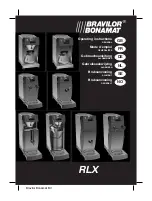
160/200/160P/200P AC/DC Series Machine
www.longevity-inc.com
Pre-TIG Welding
As you get to know the above information of basic TIG welding applications, there are a couple of basic steps
that need to be taken. The tungsten must be sharpened and shaped before initiating an arc. With inverter TIG
welding machines, tungsten sharpness is important. Your weld’s outcome will be partially determined by the
shape of your tungsten. Sharpening an electrode consistently will cause an unstable, wandering arc, making it
more difficult to control the weld puddle. Carefully rotate the tungsten as it is being ground to prevent a flat
spot or a hollow ground point. Also note that tapering the tungsten to 2.5 times of its diameter is generally
recommended for most DC welding applications. For high amperage DC welding, do not over sharpen the
point, but leave a slight truncation on the end of the tungsten. This prevents the tungsten tip from breaking away
and falling into the weld. AC TIG welding may cause a formation of a ball to develop on the end of the
tungsten. This is normal. However, if a large globular ball begins to form, re-sharpen the tungsten and adjust the
AC balance. It is also normal for a slight dome to form on the tungsten in DC mode. However, if the arc
becomes erratic or the arc is difficult to start, regrinding the tungsten will be necessary. If the tungsten is
accidentally dipped into the weld puddle, regrinding the tungsten will be necessary to eliminate contamination,
particularly on aluminum. Grind tungsten’s only on a dedicated stone, free of contamination from other metals.
Starting a TIG Weld
: Filler rod selection is critical to a TIG welds density, strength and purity. Check out our
filler rod selection chart on our website for optimum filler rod to properly complete a weld. In certain
applications, TIG welding can be performed without the use of a filler rod. One of the biggest issues for
beginning welders is holding and maintaining an arc. Starting an arc with your High Frequency welder is quite
simple. Set the machine for TIG operation then select the desired amperage. Grasp the torch in a manner that is
comfortable to you. Place the torch so that the tungsten is no more than 1/8 inch from the weld surface.
Depending upon the setup, either press the foot pedal down or press (2T setting) the trigger to initiate the high
frequency arc. A small blue glowing cone may be observed. This is the high frequency arc. Immediately after
that, you should see a strong and stable arc flowing from the torch. As the arc begins to grow, a molten puddle
will appear. If it does not appear, stop your weld and increase the amperage. Repeat the start sequence.
1. To help the molten puddle form, slowly make small circles with the torch to build the heat in the weld area. A
bright, fluid puddle will begin to form.
2. Once a uniform puddle is established, tilt the torch head about 75 degrees from the weld surface into the
direction of the weld. This will direct the arc to the front of the weld puddle.
3. Grip the filler rod at a 15 degree angle to the weld surface with the other hand. Hold the rod in the iridescent
cone of gas that surrounds the weld puddle. Do not hold it in the arc. Keep it close to the weld. A “skeleton”
keyhole will begin to form in front of the weld. The keyhole is evidence that you are ready to add filler material
and move forward. Introduce the filler rod into the key hole area underneath the arc. Wait for a single molten
drop to fall off the tip of the rod.
4. When a molten drop falls from the rod, quickly remove the rod, keeping it inside the gas cone. The molten
drop of filler metal should blend quickly into the puddle.
5. Move the torch forward slightly, carrying the keyhole with the weld. If the key hole is lost, then forward
travel was too fast or too far. When the keyhole shows good development, repeat the steps 3-5 until you have a
proper weld bead established.
6. Weld termination. When the weld bead has reached the desired length, add a final drop of filler and slowly
circle the torch over the end of the weld to fill the crater. If the weld crater is not correctly filled, cracking and
weld failure may occur. This is a small but important step to properly completing a weld. Release the foot pedal
or release the trigger to stop. Keep the TIG torch in place until the post flow ends--usually around 5 seconds.
7. When finished welding always let the welder's fan run for a minute or two to cool the machine before turning
the power switch off.











































